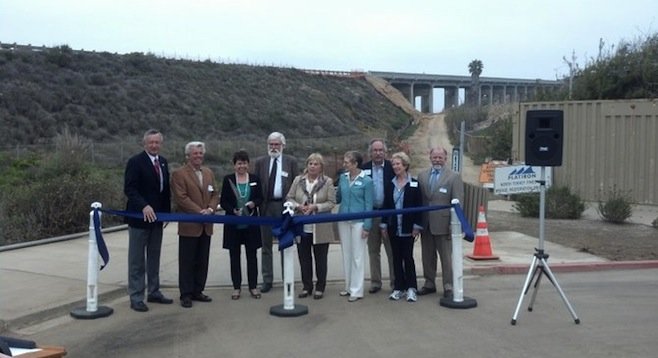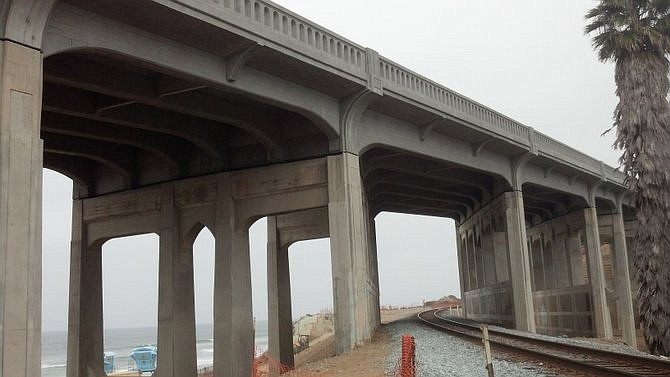 Facebook
Facebook
 X
X
 Instagram
Instagram
 TikTok
TikTok
 Youtube
Youtube

A ceremonial ribbon-cutting on Tuesday morning, April 15, marked the completion of the lengthy restoration process for a historic bridge between San Diego and Del Mar.

The North Torrey Pines Bridge, named in 1996 at the same time it was declared a historical landmark, was originally built in 1932 and 1933. It's one of the few surviving bridges constructed in the "coastal cast concrete" style during that era.
Due to age and updated earthquake-safety technology, the bridge had long been due for replacement or, due to its historic status, a seismic retrofit. But engineers faced multiple challenges: no clear ownership (when Del Mar incorporated as a city, the boundaries between the new municipality and San Diego were drawn down the middle of the bridge), coastal traffic along North Torrey Pines Road that couldn't feasibly be re-routed for an extended period, and Amtrak rail tracks passing beneath the bridge's central span.
San Diego began to pursue funding through the Federal Highway Administration and the state's Caltrans authority for a retrofit of both the North Torrey bridge and another several hundred yards to the south in the 1990s, but later ceded authority to Del Mar, selling their ownership interest to the northern city for one dollar.
Through a collaboration involving Del Mar, Caltrans, and the Federal Highway Administration, construction began in June 2010. Federal funding covered approximately 80 percent of the retrofit's $21 million price tag, with the remainder coming from Del Mar.
Work continued for nearly four years, as construction crews were forced to work around Amtrak schedules and care was taken to avoid road traffic closures on the six-story-high span with a surface area authorities said covered the equivalent of more than two football fields.
State and local officials, current and past Del Mar City Council members who worked on the bridge project, as well as a vintage car club showing off vehicles from the era of the project's original completion, attended the event and hiked up to gaze at the surf from underneath the bridge's new supports, which are expected to extend its life for at least another 50 years.


A ceremonial ribbon-cutting on Tuesday morning, April 15, marked the completion of the lengthy restoration process for a historic bridge between San Diego and Del Mar.

The North Torrey Pines Bridge, named in 1996 at the same time it was declared a historical landmark, was originally built in 1932 and 1933. It's one of the few surviving bridges constructed in the "coastal cast concrete" style during that era.
Due to age and updated earthquake-safety technology, the bridge had long been due for replacement or, due to its historic status, a seismic retrofit. But engineers faced multiple challenges: no clear ownership (when Del Mar incorporated as a city, the boundaries between the new municipality and San Diego were drawn down the middle of the bridge), coastal traffic along North Torrey Pines Road that couldn't feasibly be re-routed for an extended period, and Amtrak rail tracks passing beneath the bridge's central span.
San Diego began to pursue funding through the Federal Highway Administration and the state's Caltrans authority for a retrofit of both the North Torrey bridge and another several hundred yards to the south in the 1990s, but later ceded authority to Del Mar, selling their ownership interest to the northern city for one dollar.
Through a collaboration involving Del Mar, Caltrans, and the Federal Highway Administration, construction began in June 2010. Federal funding covered approximately 80 percent of the retrofit's $21 million price tag, with the remainder coming from Del Mar.
Work continued for nearly four years, as construction crews were forced to work around Amtrak schedules and care was taken to avoid road traffic closures on the six-story-high span with a surface area authorities said covered the equivalent of more than two football fields.
State and local officials, current and past Del Mar City Council members who worked on the bridge project, as well as a vintage car club showing off vehicles from the era of the project's original completion, attended the event and hiked up to gaze at the surf from underneath the bridge's new supports, which are expected to extend its life for at least another 50 years.
Comments